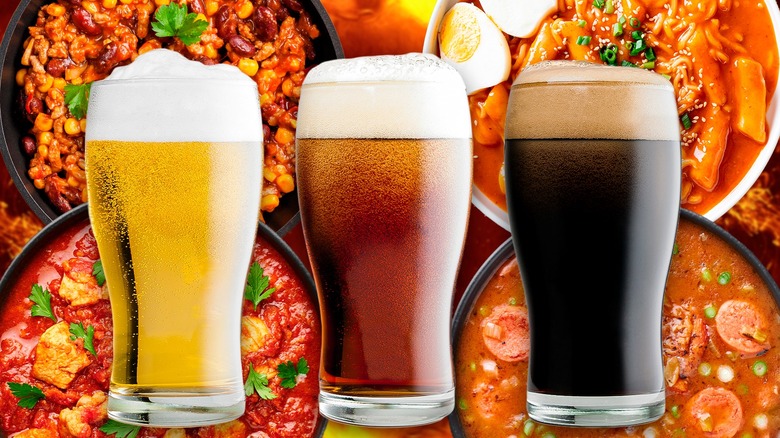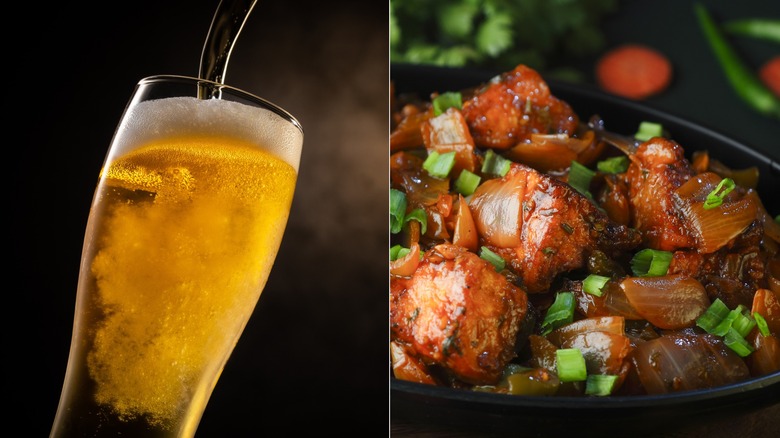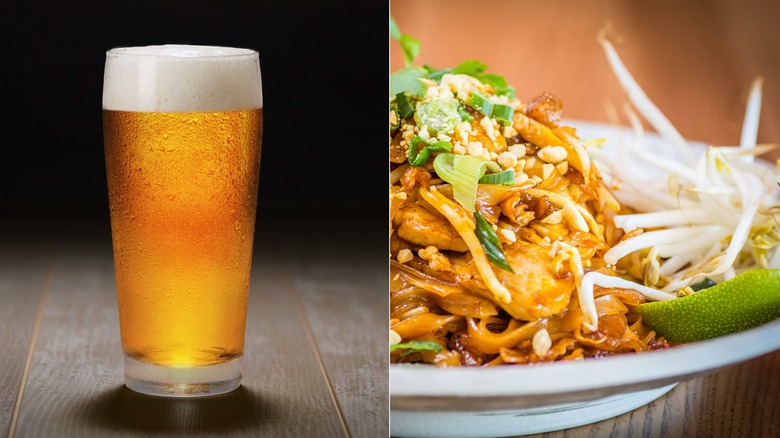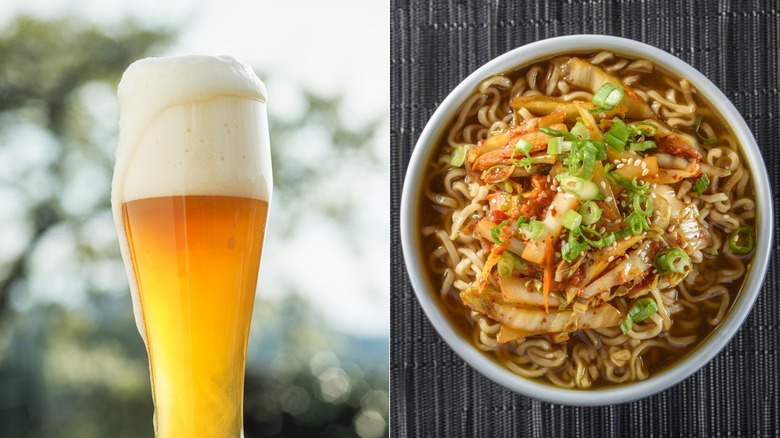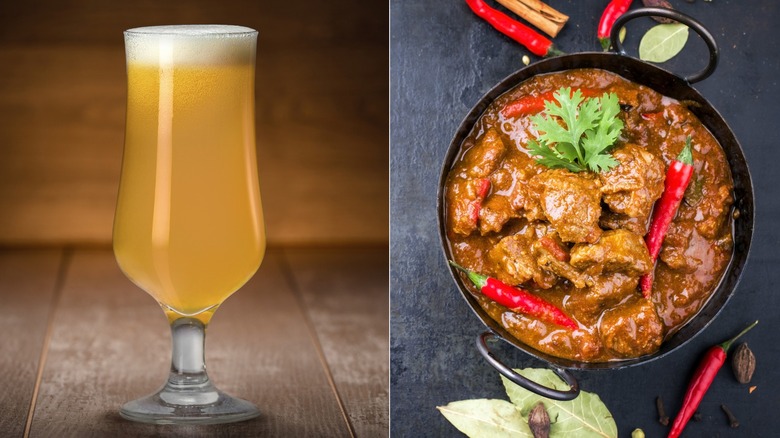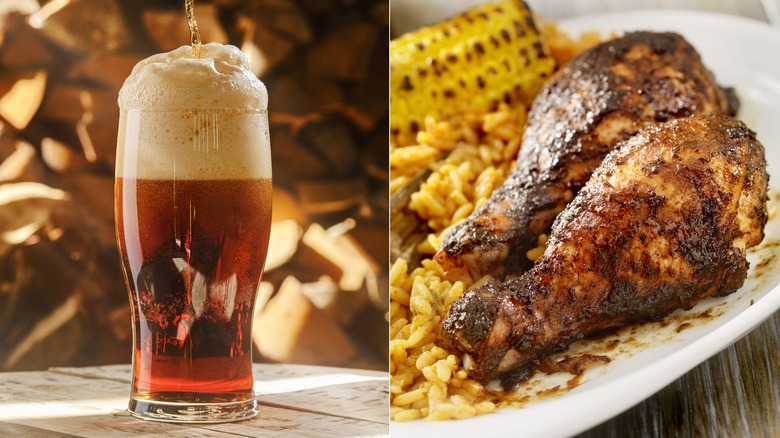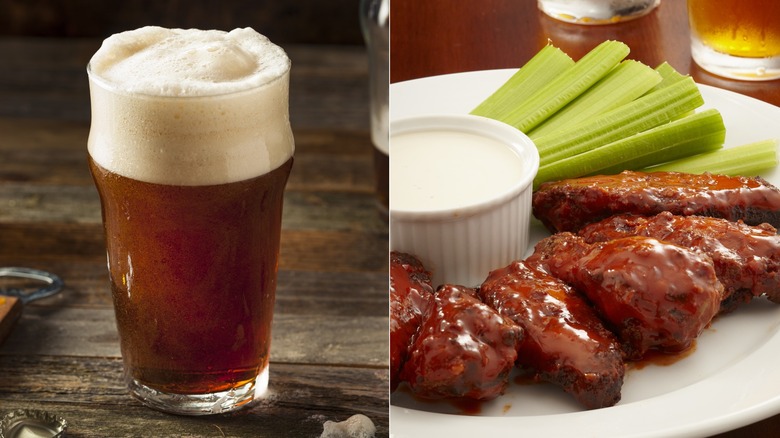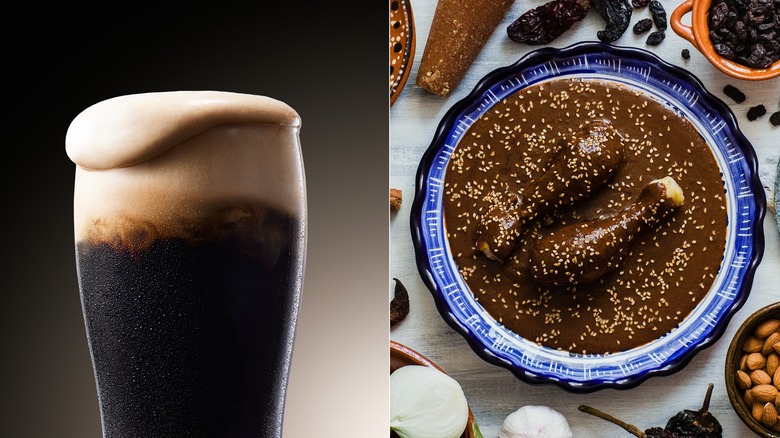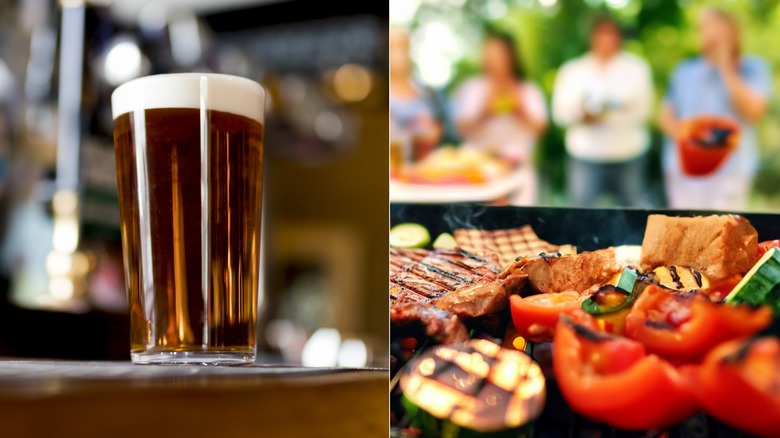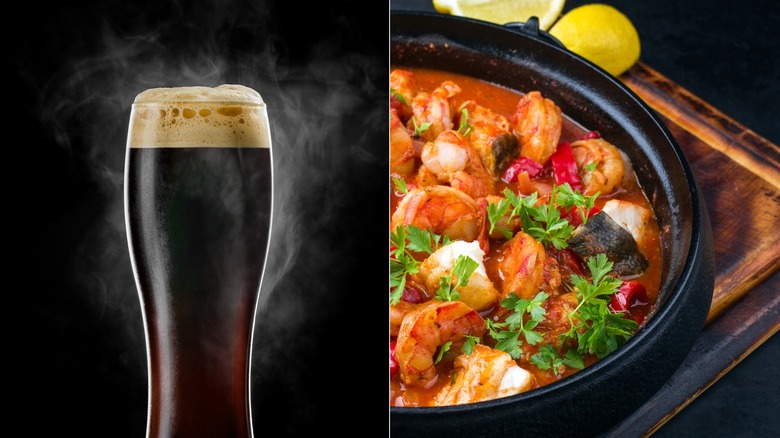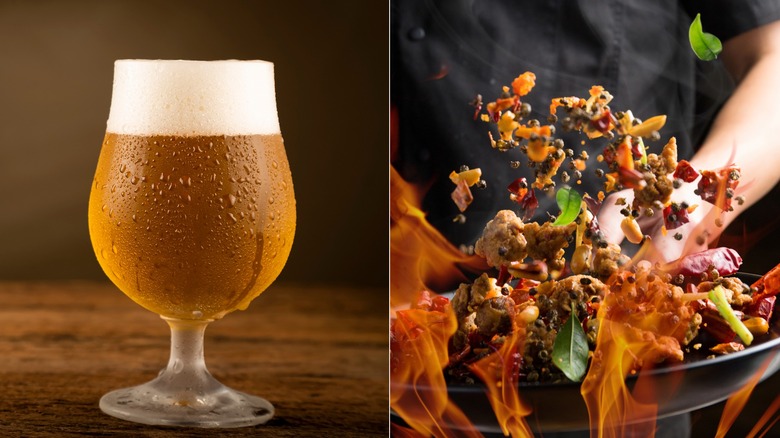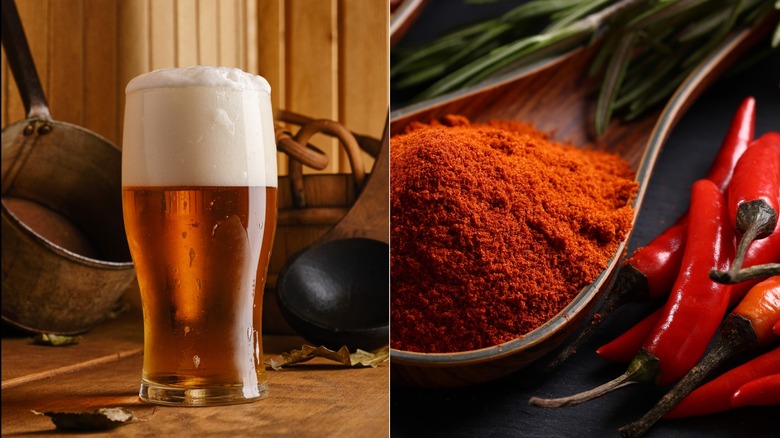The Best Beer Pairings To Balance Spicy Foods, According To An Expert
When faced with eating a fiery dish, there's nothing better than a refreshing beer to take the edge off. But it's a bit of a misconception that beer always tempers spice — and even if a brew does reduce the heat? It may be a poor choice in terms of flavor pairings. Light beers can be overwhelmed by powerful flavors, after all, while robust varieties tend to smother more delicate dishes.
My experience in the beer and hospitality industries has taught me it's far better to take the time to understand different styles of beer and their nuances — then match them with food accordingly. Of course, it's important to understand the different aspects of taste and flavor pairings when it comes to food, as well. For example, sweetness naturally balances spice, salt can reduce bitterness, and citrus can cut through fat.
With that in mind, I've compiled a list of my favorite beer styles to drink with spicy foods and coupled them with dishes genuinely elevated by the combination of flavors between the beer and food. These pairings won't just result in a superior dining experience –- they'll open your eyes to the potential of various beers and offer inspiration to seek your own delicious combinations.
Pilsner and tikka masala
Many people might initially think of pairing spicy food with a refreshing lager. While most ice-cold lagers will temper the heat of piquant dishes, you'll be doing your taste buds a disservice if you don't put more thought into the pairing. Even the best lagers can have trouble standing up to intense heat and bolder taste profiles. Consequently, pairing lagers — like a pilsner — with milder dishes will allow the beer's characteristics to shine and balance your dish.
Pilsners are an ideal lager style for pairing with mildly spicy foods because they're crisp and clean, and contain a healthy dose of European noble hops that impart spicy, earthy, and floral notes. Balanced with soft, slightly sweet pilsner malts, the style is carbonated enough to cleanse the palate between sips — but not so much as to agitate your taste buds and dial up the heat of spicy food.
A classic, European-style pilsner pairs quite well with Indian food, and a mild tikka masala is ideal given its creamy tomato base and delicately fragrant spices. My go-to is a Czech Pilsner Urquell (it's the beer almost every other pale lager derives from). I'm also partial to the slightly less bitter Pilz from the Live Oak brewery in Austin, Texas.
American pale ale and pad thai
When matching beer and food, you want to consider how the flavor components of each either complement or contrast the other. With pale ales, the most prominent flavors and aromas come from hops — but not all hops taste the same. Hops from Australia and New Zealand lean towards stone fruit and white wine, while American hops can be resinous and piney. But American hops are also well known for big hits of citrus and tropical fruit, which makes American pale ales perfect for pairing with spicy cuisine.
In fact, nothing pairs better with a robust American pale ale than Thai food. This style of beer is an excellent match for dishes like pad thai, as American pale ales complement the prominent lime, ginger, peanuts, and chili in the classic dish.
I prefer the grapefruit-like citrus and piney nose of Sierra Nevada's Pale Ale alongside pad thai, but higher-strength pale ales work, too. The alcohol can cut through the slightly oily rice noodles and reduce the greasy mouthfeel that's common with pad thai. Keep in mind that increasing the strength will also gradually increase the flavor intensity and the heat.
Wheat beer and spicy ramen
Wheat beers are another member of the lager family that can mesh well with hotter dishes. However, a bad pairing can throw off their unique flavors — especially with German and Belgian-style weizens. Now, while most wheat beers are on the sweeter side, American versions tend to be less so (unless the brewer has added other flavoring ingredients). Conversely, European wheat beers have something a bit different going on due to the yeast they use.
Since this yeast boasts some particularly interesting flavors and aromas thanks to compounds known as esters and phenols, German and Belgian styles both have spicy, peppery elements and a palate-cleansing effervescence. The former usually boasts notes of clove and banana, as well, and the latter contains hints of citrusy orange. This makes each traditional European wheat beer a superior choice for food pairing – especially when it comes to dishes like spicy ramen.
The fruity aspects are excellent for cutting through the heat of spicy ramen and balancing the savory umami flavors. Lighter broths are the best bet as they won't overpower the beer. My top pick for a citrusy pairing is a Belgian Hoegaarden (bolstered by orange and coriander). For a German weizen, it has to be the ever-delicious Hefeweissbier — a beer produced by the world's oldest brewery, Wiehenstephaner, which has made beer since the 11th century.
Milkshake IPA and lamb madras
Some believe IPAs (or India Pale Ales) are the number one beer choice for pairing with spicy foods. But that's a hard generalization to make. For starters, depending on the ingredients and how it's made, IPAs can vary wildly in terms of strength, flavor, aroma, and bitterness. IPAs that are too strong will increase the heat of the spice thanks to the additional alcohol burn, while those that are extra bitter will enhance the overall bitterness of the spicy ingredients. That being said, it's possible to find IPAs that are bold enough to match up to strongly flavored dishes without being too boozy or bitter.
The juicy, hazy New England-style IPA is one way to go, but my personal favorite is a creamy milkshake IPA. Milkshake IPAs are hazy IPAs brewed with lactose -– a milk sugar that won't ferment -– to introduce an extra smooth mouthfeel. They're often brewed with extra fruit to complement the American hop flavors, and the sweet creaminess of milkshake IPAs does an excellent job of tempering the spice with a zingy, succulent dish like lamb madras.
Lamb madras is my personal favorite for enjoying with a milkshake IPA. The dish's complex and robust flavors pair fantastically with a mango-based variety like Northway Brewing's Mango Milkshake IPA. Variants made with fruits like apricots or lychee can take on the role of a traditional lassi, as well, and work when matched with other fiery Indian dishes like a vindaloo.
American amber ale and Jamaican jerk chicken
American amber ales began taking off in popularity when the modern craft beer movement began gathering steam in the 1980s. Taking inspiration from British pale ales and "bitters" –- the beer style common in Britain, not the cocktail ingredient –- amber ales are known for their prominent malt characteristics.
By using roasted caramel and crystal malts — special malt varieties that give beer a caramel flavor – amber ales boast flavors of caramel, toasted bread, and graham crackers. This malt profile is balanced out with elements of pine and citrus from American-grown hops, which also give the beer a moderate bitterness. The sweeter nature of American amber ales helps temper spice in food while complementing fruitier ingredients. Amber ales always work well with barbeque food, but for the best pairing? Try quaffing one with hot and tangy Jamaican jerk chicken.
Many jerk dishes make use of scotch bonnet chilis which, while known for their extreme heat, have a deliciously fruity quality to them. American ambers aren't particularly strong, so they'll complement the mild spiciness of jerk cuisine. My favorite has to be Bell's Amber Ale. The brewery's first commercial beer, it was launched way back in 1985 and exemplifies the style. It boasts an extremely clean bitterness and demonstrates the perfect balance between the hops and malts — making it remarkably versatile for pairing with dishes like this flavor-packed jerk chicken recipe.
Brown ale and buffalo hot wings
Brown ales are the next step up from ambers on the dark beer scale. Both have long and storied histories in England that stretch back centuries, and both eventually gained popularity in the United States (albeit with some modifications). Brown ales still use crystal malts, but they tend to use darker, more highly roasted chocolate malts, as well. Roasting the malts further unlocks richer, toastier flavors like nuts, dried fruit, chocolate, and toffee. The hops tend to sit back and let the malt do the heavy lifting taste-wise, but the bitterness is ramped up slightly to counter the increased sweet and fruity elements.
Generally, the American version is the darker and more bitter of the two. Either way, brown ales are hugely versatile when it comes to drinking with spicy food. They pair well with slightly sweet and nutty dishes like chicken satay and massaman curry — but I've yet to find a better match-up than tangy buffalo wings.
A brown ale's sweetness effortlessly zips through a vinegary hot sauce and pungent blue cheese dip, while its bitterness helps cut through the richness of the sauce and deep-fried chicken meat. I recommend trying Newcastle Brown (a British classic that uses American hops), while Brooklyn Brewery's brown ale is more fully flavored — and ideal for pairing with bolder dishes with more prominent spice.
Stout and mole poblano
We come to the end of the dark beer spectrum with stouts. This polarizing style is detested by some but lauded by connoisseurs as the pinnacle of brewing. The malts are roasted black for stouts — lending them their signature inky coloring. Gone are the hop flavors, though, as the high-roasted malt dominates the entire palate with waves of burnt toffee, rich coffee, and decadent chocolate. The hops in stouts mainly provide varying degrees of bitterness to balance the style's notable malt sweetness.
Irish dry stouts, like the ubiquitous Guinness, are more bitter than the American style. But both can be infused with nitrogen to reduce bitterness and create a deliciously creamy texture. You've also got English varieties like oatmeal stouts with their extra robust mouthfeel, and milk stouts that are sweetened with lactose. Now, some may avoid pairing stouts as they're the polar opposite of a cold, refreshing lager. However, a stout's flavor profile makes it excellent for matching with richer foods.
While a sweeter and creamier stout will better temper spice, the style's huge malt profile demands a bold food pairing, and Mexican food is a fantastic pick. Stouts are especially great alongside a classic mole dish like the celebratory dish of Cinco de Mayo in mole poblano. The nutty, chocolate-infused chili sauce begs for a stout pairing, after all. I prefer Deschutes' Obsidian Nitro Stout when I can get my hands on it, but I'm happy to revert to Guinness in a pinch.
Cream ale and smoky barbeque
It should be noted there's no cream in cream ale, nor is there any lactose. In fact, there's nothing especially creamy about cream ales — and nobody seems to know where the name came from in the first place. What we do know is that around the middle of the 19th century, American brewers started to fall behind European-style lagers, and reacted by inventing an ale that emulated their competition's beer.
Cream ales can be brewed with either ale or lager yeast, fermented at ale-like temperatures, and then matured at cooler temperatures in a process called lagering. This process not only cuts down on fermentation time but helps cut costs — and increase profits — by replacing part of the mash bill with an adjunct (typically corn). While cream ale isn't as common as it used to be, it's a smooth, crisp, easy-drinking style of beer that manages to avoid tasting watery and flat despite its quaffability.
Since it won't necessarily stand up to overly intense dishes, a cream ale's corn sweetness is a deliciously refreshing option on a hot summer's day with smoky barbeque dishes. It's the perfect beer to drink with a properly seasoned plate of barbeque, and I'd recommend Genesee's Cream Ale (which is likely the best representation of the traditional cream ale style).
Black lager and gumbo
An often overlooked beer style, black lager is starting to make a reappearance outside of mainland Europe. It's historically been popular in the Czech beer scene and is most commonly associated with German brewing, where they're referred to as "schwarzbier" –- literally, black beer. Black lager is probably just what you'd expect it to be. It's a lager that's made with heavily roasted dark malts and has the toastiness of a stout while retaining the style's light, refreshing qualities.
Traditionally, the beer pairs best with hearty European fare, but its moderate sweetness and lower bitterness make it a solid pick for balancing spice, too. Of course, if you're familiar with German and Czech cuisine, you'll probably note that neither is known for spicy dishes — so we might need to look elsewhere. Fortunately, there are two related cuisines well known for hearty dishes that bring the heat: Louisiana creole and cajun.
Both cuisines have deep roots in French cooking that deftly incorporate the foods and recipes of North America's native people and settlers. Spicy stews -– like the different-but-similar gumbo and jambalaya –- are given depth by the roasted beer flavors, while the heat is held at bay by the lager's coolness. Interestingly, one of the best black lagers around –- Černé Speciální from Utopian Brewing –- is from southwest England rather than black beer's historic homeland.
Saison and Sichuan stir fry
Saisons are something of an acquired taste. Unless you're Belgian or a bit of a beer geek, there's a chance you've never encountered this style before. Its origins lie in the French and Belgian countryside, where it was brewed as a light, refreshing beverage for farmhands to consume as they toiled away in the summer heat.
Saisons aren't too strong from an alcohol perspective (we can't have our farmhands getting too merry), but they're uniquely flavorful thanks to their brewing process. For starters, the mash bill can include a range of grains that add complexity to the beer. Saisons are usually heavily hopped thanks to the ingredient's preservative properties, and many brewers introduce wild yeasts, as well. The lack of strict guidelines means saisons can be tart, floral, fruity, or even funky, with desirable off-flavors that one can only really describe as farmyard-like.
The pinnacle of the saison style is the famous Saison Dupont from Belgium. This beer matches exceptionally well with the citrus and peppery spice of Chinese dishes like Sichuan stir fry. The Saison Dupont contains notes of grapefruit and clove — a winning combo with an earthier dish like a roasted butternut squash Sichuan stir fry. Generally, saisons are bone dry without much perceivable sweetness, but there's more than enough variety within the style to experiment with different foods and cuisines.
Steam beer and everything
Like cream ale, steam beer is another American hybrid style that manages to combine the best aspects of ales and lagers. Born out of necessity, steam beer was first being brewed by pioneers during California's gold rush – hence its alternate name California Common. The Europeans emigrating to California to find their fortunes were lager drinkers, but the temperatures meant they had to brew their beer at ale temperatures. Once they found a lager yeast strain up to the task, they had to make do with the limited ingredients available, so the barley-based mash bill was bolstered with other grains, like rice and corn.
The style's popularity waned as refrigeration became more widespread — at least until Anchor Brewing breathed new life into steam beer in the early 1970s. However, Anchor has since trademarked the term "steam beer," so all other US-based breweries now have to call the style California Common instead. In all fairness, Anchor's version does set the gold standard for steam beer, with a crisp malty profile and a fruity, hop-forward ale-like complexity.
Steam beer isn't going to introduce you to mind-blowingly unique flavors. But its versatility means it'll do the job with ease if you're lost on which beer to pair with spicy food. Whether Mexican, Thai, Indian, curries, soups, stews, or anything else, steam beers will cool your tongue, cleanse your palate, and enhance food flavors without overpowering them.
Methodology
Years of experience in the beer industry have given me the good fortune of trying a countless array of beer styles from brewers across the world. At the same time, as a longtime bar and restaurant manager, I've been tasked with stocking beers that taste just as great with food as they do on their own — including a variety of spicy cuisine.
The recommendations above are the result of years of experimentation with tasting beers, running beer schools, creating drinks lists, and working with chefs to learn the secrets of food pairings. I've tried and tested all of the beers I've listed by name, as well as all the suggested combinations for beer and spicy dishes.
